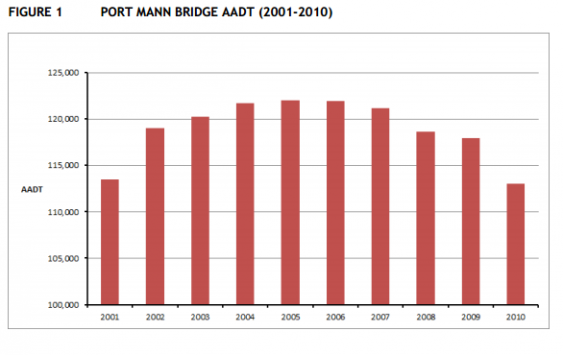Unsurprisingly to regular readers of this blog, traffic on the Port Mann Bridge in Surrey, BC peaked in 2005, and then fell modestly but steadily through 2010.
 That said, there’s no telling what this means for the future. A new, 10-lane Port Mann Bridge—certified by the Guiness Book as the widest bridge in the world—is nearing completion, and three lanes of the bridge have already been opened to traffic. A wider Port Mann crossing will likely be less congested than the current bridge, at least at first; and history has shown that free-flowing urban highways tend to attract new drivers. But it’s also tolled bridge—$1.50 each way for the first year, $3.00 and potentially rising with inflation thereafter—and tolling tends to reduce traffic volumes. Toss in some uncertainties around oil prices, vehicle efficiency, land use, and government policy, and there’s just no telling what the future traffic trajectory might be.
That said, there’s no telling what this means for the future. A new, 10-lane Port Mann Bridge—certified by the Guiness Book as the widest bridge in the world—is nearing completion, and three lanes of the bridge have already been opened to traffic. A wider Port Mann crossing will likely be less congested than the current bridge, at least at first; and history has shown that free-flowing urban highways tend to attract new drivers. But it’s also tolled bridge—$1.50 each way for the first year, $3.00 and potentially rising with inflation thereafter—and tolling tends to reduce traffic volumes. Toss in some uncertainties around oil prices, vehicle efficiency, land use, and government policy, and there’s just no telling what the future traffic trajectory might be.
Of course, the province is betting big on long-term traffic growth—they need the cars to show up, since they’re hoping to use toll revenue to pay for their highway-building binge. But if traffic grows more slowly than they hope, then it’ll take an awful long time for the province to pay for that bridge.
(Hat tip to Joe Cortright.)


Comments are closed.